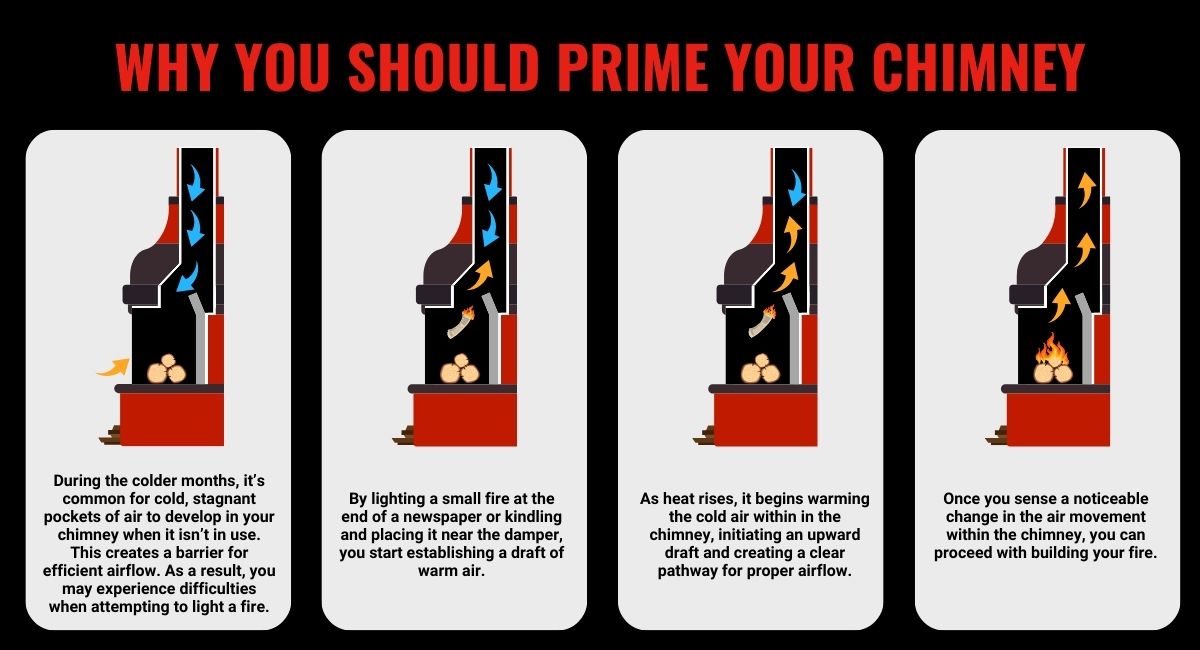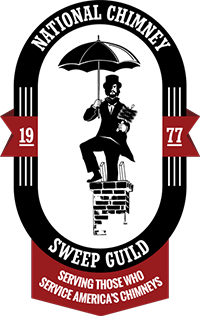During these months of short daylight hours and cold temperatures, there is nothing quite like getting a blazing fire roaring in your fireplace or wood stove. Everything about it – from the crackling sounds to the dancing flames – can really help you relax and recharge. All that said, though, nothing is more frustrating than struggling to get the fire going and having to deal with smoke pouring into your living space.
Why does your fireplace backdraft when it’s cold? When lighting a fire in a fireplace that hasn’t been preheated, you may find yourself battling that wall of cold air, which pushes it back, quite literally, into your face…meaning you get a lot of smoke without any fire.
Fortunately for you, our chimney experts here at Chim Cheroo know how to get a chimney working properly and a fire burning efficiently. Questions? Give us a call or reach out online. We’ve got your back.
Starting a Fire in Your Fireplace: Why Is Priming Your Chimney Important?

Ever wondered why giving your chimney a little warm-up is a good idea? Well, when the chilly season rolls in, your chimney might just become a cozy home for pockets of cold, still air when it’s not in use.
Picture this: you’re all set to light up a warm, crackling fire, but those stubborn air pockets are playing spoilsport, making it a struggle. So, here’s the trick: grab a newspaper or some kindling, light up a small fire, and cozy it up near the damper.
This little flame not only adds a touch of warmth but also kickstarts a draft of toasty air. As the heat rises, it starts melting away the chilly air in your chimney, paving the way for a smooth upward draft. Suddenly, it’s like your chimney is taking a deep breath of warm air, creating a clear path for that perfect fire.
Once you feel that change in the air – a noticeable shift from chilly to cozy – you’re good to go. Time to turn that spark into a roaring fire and embrace the warmth!
How To Prime Your Chimney or Flue
Priming or preheating your chimney is the act of warming up the flue so that air pressure within your firebox and your chimney work together to move air up and out of your home. If the firebox is hot and your flue is cold, air gets stuck and downdrafts can occur. This robs the fire of oxygen and kills the flames, forcing smoke inside. That is why it is important to know how to warm up the chimney before you start your fire.
There are a number of ways you can prime your chimney. All of them involve taking enough time to slowly bring your flue up to a high enough temperature to initiate upward drafts. The key is not to rush it. A little patience will have you curled up in front of a roaring fire in no time.
✓ Correct Kindling Is Key
Kindling is a small, easily combustible material that will give off lots of heat with a little smoke. Rather than using large logs at first, light dry wood chips, pellets, or shavings. The lit kindling will allow the temperature within the flue and firebox to increase without the same demand for oxygen…meaning you won’t get a buildup of smoke in your fireplace or wood stove.
Now, there are many types of kindling available including wood and paper products. We discourage the use of these materials as fuel in your fireplace or wood stove. They don’t burn cleanly, sending a byproduct called creosote into your chimney. This creosote builds up on the lining of your flue and is extremely susceptible to combustion. Creosote buildup is a leading cause in chimney fires, which pose a danger to your home and everyone living inside.
✓ Open Up the Damper
Your damper is an important part of your chimney system. It keeps cold air from creating downdrafts into your chimney and home. However, if it is closed it will not allow needed airflow in and out of the chimney. This means that fires will be hard to light and maintain. It also means that the only place smoke will be able to go is into your home. Make sure your damper is open before you begin warming the chimney.
✓ Warm Up the Firebox
Different components within the firebox can absorb the heat, so that it doesn’t rise up and warm the chimney. Masonry and metal within the firebox, if cold, will steal the heat from your warming attempts and prevent the chimney from heating up. Carefully use a hair blow dryer or fireplace matches to warm the components within the firebox first so that your further efforts to warm up your chimney will work.
✓ Torch the News
One way to get your chimney warm is by rolling up a couple pages of newspaper into a tight funnel shape. Light the wide end of this newspaper torch so that it is burning. Hold the torch in your firebox so that the heat from the burning end escapes through the damper and up the chimney. Though this process takes a few minutes to work, it will warm up your chimney and have you sitting in front of a roaring fire before you know it.
✓ Use a Chimney Starter
A chimney starter is a metal cylinder with holes around the bottom that allow kindling to sit within it and air to circulate around it. It condenses the kindling into the smaller space within the cylinder and causes increased heat to rise quickly. It is the quickest and cleanest way to get your chimney warmed up.
Regular chimney care and maintenance are perhaps the most important part of making sure your chimney is working correctly. Like any important part of your home, preventive maintenance – like keeping it clean and in good working condition – is key to being able to fully enjoy it.
Questions? We’re Here To Help
The Chim Cheroo team of experts are fully trained to inspect chimneys and spot problems long before they become expensive hazards. We’re equipped with the tools to clean chimneys and keep them free of harmful buildup, and we also have the skills necessary to make repairs when needed. Call us today – or book online – and let ensure you are able to enjoy your fireplace or wood stove for years to come.


